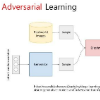Traffic forecasting is an essential problem in urban planning and computing. The complex dynamic spatial-temporal dependencies among traffic objects (e.g., sensors and road segments) have been calling for highly flexible models; unfortunately, sophisticated models may suffer from poor robustness especially in capturing the trend of the time series (1st-order derivatives with time), leading to unrealistic forecasts. To address the challenge of balancing dynamics and robustness, we propose TrendGCN, a new scheme that extends the flexibility of GCNs and the distribution-preserving capacity of generative and adversarial loss for handling sequential data with inherent statistical correlations. On the one hand, our model simultaneously incorporates spatial (node-wise) embeddings and temporal (time-wise) embeddings to account for heterogeneous space-and-time convolutions; on the other hand, it uses GAN structure to systematically evaluate statistical consistencies between the real and the predicted time series in terms of both the temporal trending and the complex spatial-temporal dependencies. Compared with traditional approaches that handle step-wise predictive errors independently, our approach can produce more realistic and robust forecasts. Experiments on six benchmark traffic forecasting datasets and theoretical analysis both demonstrate the superiority and the state-of-the-art performance of TrendGCN. Source code is available at https://github.com/juyongjiang/TrendGCN.
翻译:暂无翻译



